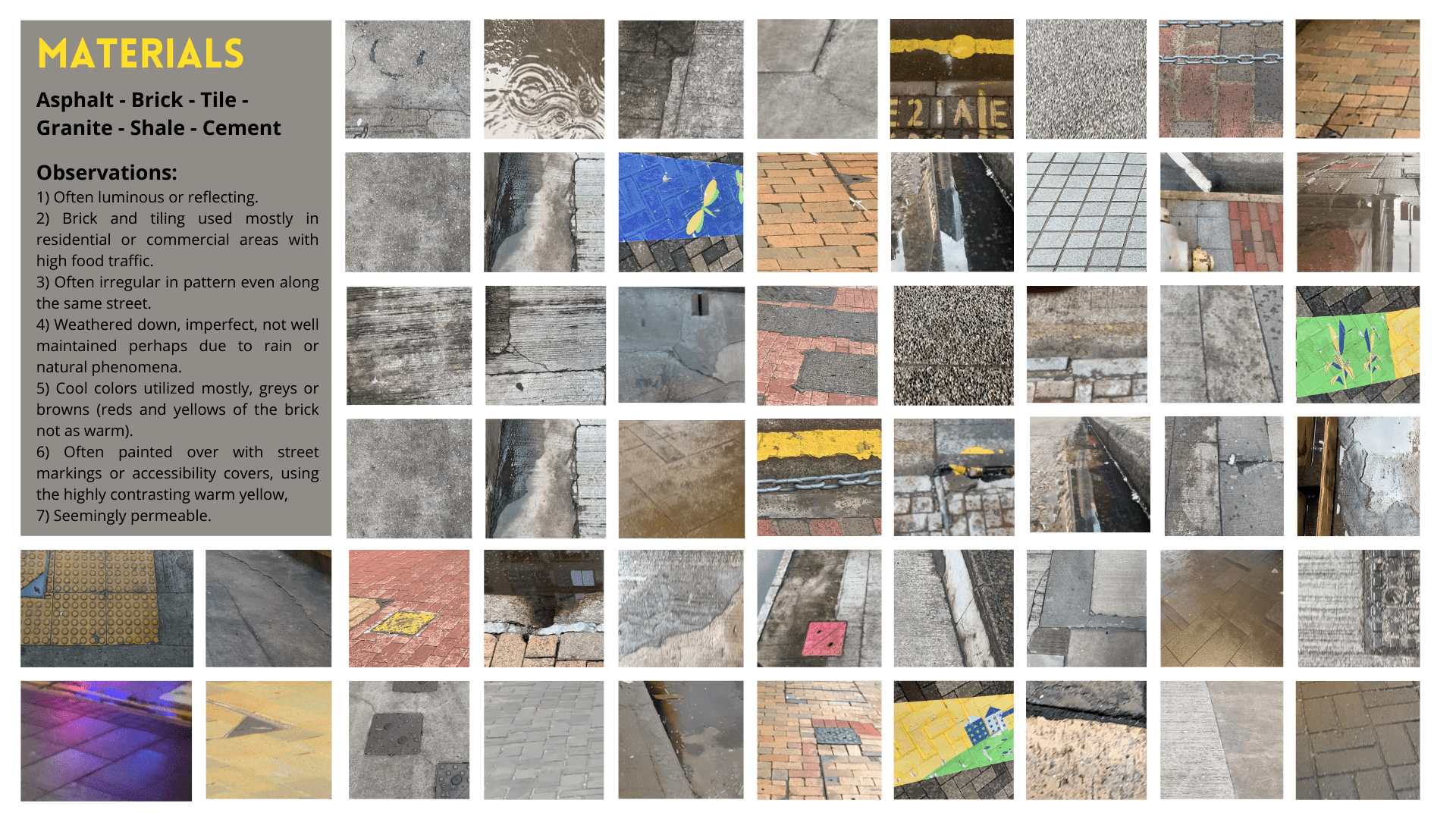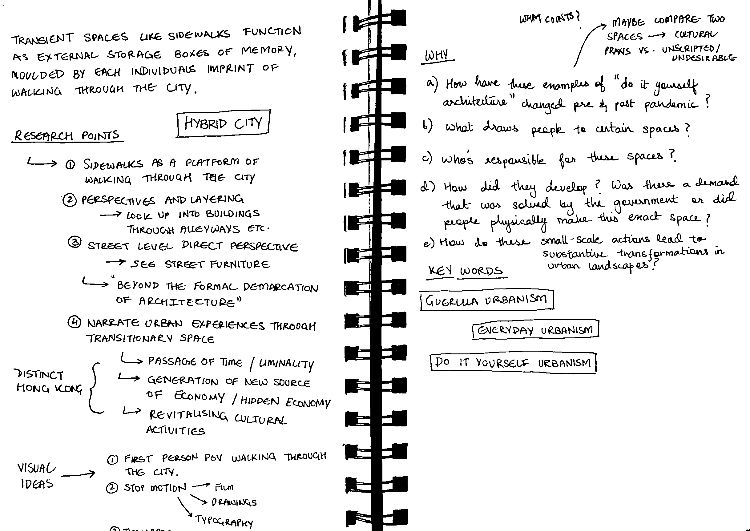Link to Video: https://youtu.be/RYcMjUZFiRs
Concept
Hypethral spaces like sidewalks are the circulatory system of walkable cities like Hong Kong. They provide an access point, a platform, like blank pages of a notebook, to fill in one’s experiences of the city. However, they seem to encapsulate a series of dichotomies- not hidden but not the focal object, open, unsheltered but restricting accessibility and routes, used by everyone but outside one’s ownership. They are public, but everyone narrates their private route, weaving in and out, sewing their traipsing experience into a communal urban fabric. Each narrative flows together, creating the mesh that highlights the experience of observing Hong Kong from a personal level.
De Certeau’s position on spatial practices, as a continual fabric transformed under “tiny deportations” (Certeau et al., 1984, pg. 103), emphasises the role narratives bear for delineating place and space. Just as words act as vessels to carry meaning, the nomenclature of ‘City’ contains the social experience. This led me to question where sidewalks, spaces beyond the demarcation of architecture, could facilitate the emotions that create ‘space.’ Further writing by Peterson-Littenberg posited: cities are not defined by individual buildings but on the connection between interactive solids and void in public spaces. With buildings lining sidewalks, they generate a boundary for the void to exist, so within the walkable mesh of “undifferentiated, formless, infinite …” anti-space (Peterson et al., 2020), objects and activities can exist.
One key concept was space through tangible objects and human experiences are perceived whilst the anti-space background is conceived amongst objects, showcasing link to Lefebvre’s spatial practice (López-Marcos, 2017). Lefebvre dictates two ideas: ‘conceived’ and ‘lived’ spaces, stating the ‘lived’ showcases how human beings retrofitting space also depicts that social setting also influences them. Essentially, modern life can be conceived as antispace (Peterson et al., 2020), amongst which finite, concrete ‘lived’ or ‘moulded’ objects lie. These objects inspired by the human walkers extend architecture beyond shelter, and can shape experiences of the city. This sparked my interest in the objects we view on sidewalks around the city.
Research Process
My methodology began with a walk through the city, and then secondary research. To understand how space is constructed, I realised it was essential to look at sidewalks more objectively and in many locations. I walked from HKU to Causeway Bay and further North Point and Shau Kei Wan. I categorised them in three different site conditions to film- old residential area and wet market in Shau Kei Wan, the commercial Central and Wan Chai, as well as the dried food market in Sheung Wan. These showcase three temporal conditions. I then created collages to depict street furniture (1) and sidewalk materials (2) to represent my findings and piece together a definition.
If we consider the area provided by sidewalks anti-space, then the space is an example of life seen on the street, the people, street furniture, extensions of shops, chairs, and cargo boxes etc. From my observations, I wanted to explore these examples of guerilla, do-it-yourself urbanism. Ostensibly, during the pandemic these public spaces were forced into being desolate, however, they are becoming populated again. By looking at congested locations, teeming with life, it was also clearer to envisage how the individual narrative pieces into a larger community dealing with the density.
Filming process
For this film, I chose to piece together quick cuts between footage from many different angles and the transitions used showcased the concept of multiple perspectives and narratives (3) of a bustling city. Crosscuts were used to move between different views of the salient image and waist-down medium shots to highlight walking through the city. When combined with walk-by transitions, the range of different POVs aimed to show the individuality in the narrative when walking through the city, and highlight the rebellion brought on by people when they create objects in the anti-space. I used transportation (like the top deck on trams) for moving shots. These were challenging as it was hard to stay stable, but the aerial shots were necessary. The film jumps between higher angle shots or shots with street furniture like poles in the foreground to communicate to the viewer that they’re also present somewhere within the fixed, dictated world but also have individual agency to impose.
Additionally, I used a website (Lindeke, 2008-2012) which chronicled representations of pedestrians on sidewalks in films as inspiration. The diegetic audio and the magazine cutout style of on-screen text attempted to give an innate rhythm. The script itself poses many questions to investigate the tug between the Lefebvrian creations and what is dictated by the city. Lastly, to extend this research, further ethnographic analysis would be very beneficial to understand the complexities of space and daily life.
(Word Count: 760, excluding in-text citations)
Appendix (All images were too large to be embedded)
1) Street Furniture Collage: https://drive.google.com/file/d/1mjwe6AeNFROcFsp6rskvy67qh1_MeMQq/view?usp=sharing

2) Material Collage: https://drive.google.com/file/d/1S6FjfS5aj4UxUoIUWnfVo9V9kmn46aEw/view?usp=sharing

3) Process

References
Audi , M., Byorkman, K., Couture, A., & Najem , S. (2010). (rep.). Measurement and Analysis of Walkability in Hong Kong . Designing Kong Hong, Ltd and The Harbour Business Forum. Retrieved May 13, 2022, from https://walkdvrc.hk/upload/files/research/20180209101800_77.pdf.
Brown, W. (2020, May 8). A new way to understand the city: Henri Lefebvre’s spatial triad. Medium. Retrieved May 13, 2022, from https://will-brown.medium.com/a-new-way-to-understand-the-city-henri-lefebvres-spatial-triad-d8f800a9ec1d
Certeau, M. de, Giard, L., & Mayol, P. (1984). The practice of Everyday Life. Berkeley : University of California Press. Retrieved May 13, 2022.
Ellis, J. G. (2020). Space and anti-space: The fabric of place, city and architecture. Journal of Urban Design, 26(2), 262–264. https://doi.org/10.1080/13574809.2020.1857647
Hou, J. (2020). Guerrilla urbanism: Urban design and the practices of resistance. URBAN DESIGN International, 25(2), 117–125. https://doi.org/10.1057/s41289-020-00118-6
Lefebvre, H., & Nicholson-Smith, D. (2016). The production of space. Blackwell Publishing.
Lindeke, B. (n.d.). Classic Sidewalks of the Silver Screen. Twin City Sidewalks. Retrieved May 12, 2022, from http://tcsidewalks.blogspot.com/search/label/classic%20sidewalks%20of%20the%20silver%20screen?updated-max=2009-06-09T09%3A29%3A00-06%3A00&max-results=20&start=80&by-date=false&m=1
López-Marcos, M. (2017). Revisiting ANTI-SPACE interview with Steven K. Peterson. Risco Revista De Pesquisa Em Arquitetura e Urbanismo (Online), 15(1), 141–150. https://doi.org/10.11606/issn.1984-4506.v15i1p141-150
Perec, G. (1997). Species of spaces and other pieces: Essays. Penguin Books.
Peterson, S., Dennis, M., Barnett, J., & Littenberg, B. (2020). Space & anti-space: The fabric of place, city and architecture. Oro Editions.
Some references were made to an original version of the articles from “Beyond the Modern Movement,” published in The Harvard Architectural Review, Harvard University, Volume 1 Spring 1980
Tan, S. (2016). The nature of community and the built environment and how they affect the intensity of contact points in cities. Retrieved May 13, 2022, from https://issuu.com/shalinntan/docs/theories_of_architecture_and_urbani.
Turner, V. W., & Bruner, E. M. (1986). The anthopology of experience. University of Illinois Press.
Walker, A. (2018, February 7). The case against sidewalks. Curbed. Retrieved May 15, 2022, from https://archive.curbed.com/2018/2/7/16980682/city-sidewalk-repair-future-walking-neighborhood
Wong, T.-K. (2019, December 3). Walkable Hong Kong: Making the city more pedestrian-friendly requires cooperation from everyone. Young Post. Retrieved May 14, 2022, from https://www.scmp.com/yp/discover/lifestyle/health-fitness/article/3069405/walkable-hong-kong-making-city-more-pedestrian
Zolee. (2019). 130 Newspaper and Magazine Cutout Letters (Png Transparent). Onlygfx.com. Retrieved May 13, 2022, from https://www.onlygfx.com/130-newspaper-and-magazine-cutout-letters-png-transparent/.
Music: Debussy, Claude, 1862-1918. ( 1986). Clair de lune. New York, N.Y. RCA Red Seal,
Well-researched video and essay with a strong hypothesis, supported by relevant concepts. The research method is clear and is well-presented in the video as well as in the essay. Your visuals have assisted you to create the mise-en-scene of the city – fast-paced and dense. I would suggest you use another background music as it is less relevant to the mood and theme of your piece.